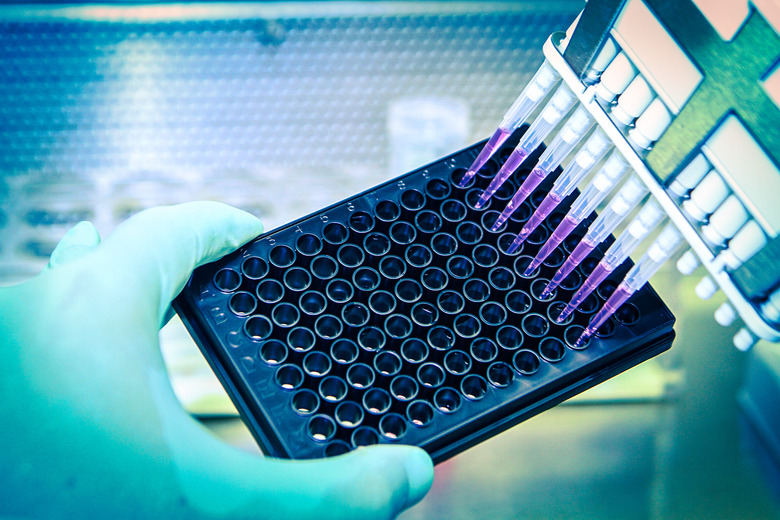What Are The Functions Of mRNA & tRNA?
Ribonucleic acid (RNA) is a chemical compound that exists within cells and viruses. In cells, it can be divided into three categories: Ribosomal (rRNA), Messenger (mRNA) and Transfer (tRNA). While all three types of RNA can be found in ribosomes, the protein factories of cells, this article focuses on the latter two, which are found not only within ribosomes, but exist freely in the cell nucleus (in cells which have nuclei) and in the cytoplasm, the main cell compartment between the nucleus and cell membrane. The three types of RNA, however, work in concert.
What Is RNA?
What Is RNA?
mRNA and tRNA exist in chains consisting of building blocks called RNA nucleotides. Each of these building nucleotides consists of a sugar called ribose, a high-energy chemical group, called phosphate, and one of four possible "nitrogenous bases"—ringed or double-ringed structures whose background is built not only from carbon atoms but from many nitrogen atoms as well (see figure). Nucleotides connect with one another by way of the phosphate and sugar groups, which form a "backbone" to which the nitrogenous bases are attached, one for each ribose sugar.
RNA's Four Nitrogenous Bases
RNA's Four Nitrogenous Bases
In most cases, four bases are found in RNA. Two of these, adenine (A) and guanine (G), contain two chemical rings and are called purines. The other two, each containing one chemical ring, are cytosine (C) and uracil (U), and they are called pyrimidines.
Synthesis of mRNA and tRNA
Synthesis of mRNA and tRNA
mRNA and tRNA are synthesized through processes called "base pairing" and "transcription," wherein a chain of RNA is laid down, alongside a strand of deoxyribonucleic acid (DNA). In bacteria and archaea, two of the three major divisions of life on Earth, RNA synthesis takes place along a single chromosome (and organized structure consisting of a strand of DNA and various proteins). In the other division of life, eukarya, RNA synthesis takes place within the nucleus, where DNA is packaged within one of more chromosomes. Both mRNA and tRNA contain information in the form of specific sequences of the four possible bases in each of their nucleotides. These sequences, in turn, are synthesized based on the sequence of nucleotides in DNA, specifically the section of the DNA (called the gene) which was used to synthesize the RNA strand during the base pairing process.
Function of mRNA
Function of mRNA
Each molecule, or chain, of mRNA carries instructions on how to connect several "amino acids" into a peptide chain, which becomes a protein. The same way that nucleotides are building blocks for RNA, amino acids are building blocks for proteins. Evolution has produced a "genetic code" wherein each of life's 20 amino acids is coded for by a series of three nitrogenous bases in RNA nucleotides. Thus, each triplet of RNA nucleotides corresponds to one amino acid, and the sequence of nucleotides dictates the sequence of amino acids that will be linked into the peptide chain that makes a protein. While in some cases an amino acid can be represented by multiple nucleotide triplets, called codons, each codon on RNA represents only one amino acid. For this reason, the genetic code is said to be "degenerate."
Function of tRNA
Function of tRNA
While mRNA contains the "message" as to how to sequence amino acids into a chain, tRNA is the actual translator. Translation of the language of RNA into the language of protein is possible, because there are many forms of tRNA, each representing an amino acid (protein building block) and able to link with an RNA codon. Thus, for instance, the tRNA molecule for the amino acid alanine has an area or binding site for alanine and another binding site for the three RNA nucleotides, the codon, for alanine.
Translation Occurs in Ribosomes
Translation Occurs in Ribosomes
The process of translating RNA codon sequences into amino acid sequences and thus into specific proteins actually is called "translation." It occurs in ribosomes, which are made of rRNA and a variety of proteins. During translation, a strand of mRNA passes through a ribosome, like an old-fashion cassette tape moving through a tape reader. As the mRNA moves through, tRNA molecules carrying the appropriate amino acid bind to the RNA codon to which they are matched, and the sequence of amino acids is put together.
References
Cite This Article
MLA
Warmflash, Dr. David. "What Are The Functions Of mRNA & tRNA?" sciencing.com, https://www.sciencing.com/functions-mrna-trna-5448833/. 13 March 2018.
APA
Warmflash, Dr. David. (2018, March 13). What Are The Functions Of mRNA & tRNA?. sciencing.com. Retrieved from https://www.sciencing.com/functions-mrna-trna-5448833/
Chicago
Warmflash, Dr. David. What Are The Functions Of mRNA & tRNA? last modified March 24, 2022. https://www.sciencing.com/functions-mrna-trna-5448833/
